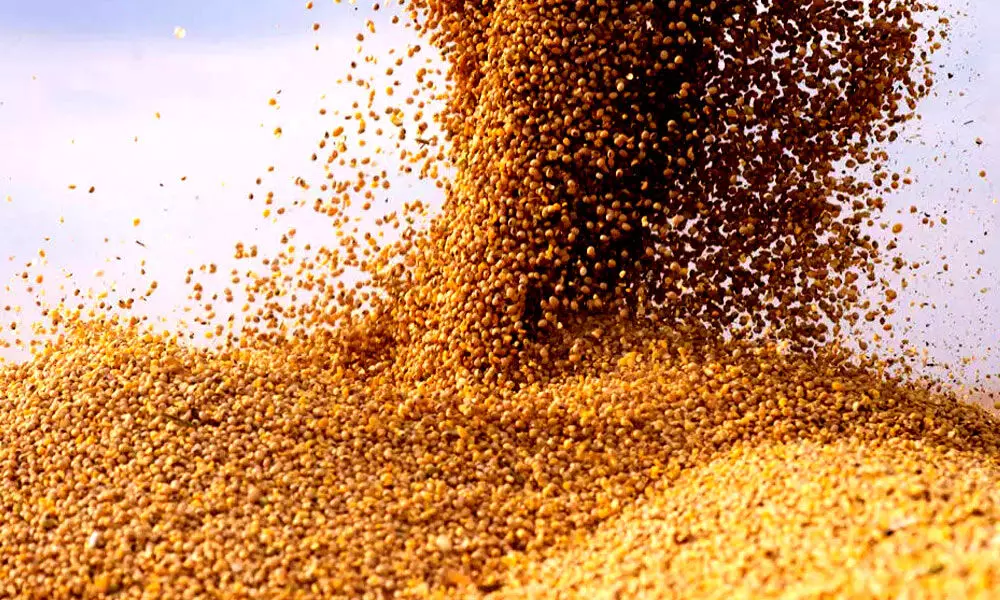Soya bean price hits fisheries and poultry
Soya bean meal is also used in manufacturing fish feeds. De-oiled cake (DOC) of soya with 46 per cent protein is used in up to 20 per cent of fish feed manufacturing processes
image for illustrative purpose

About 15 lakh farmers are involved in inland fish culture and at least 100 lakh people depend on this sector for production, marketing of fish and other related activities. The steep increase in DOC prices coupled with the scarcity of DOC has also been adversely affecting the fish production and related activities
Visakhapatnam: HEFTY increase in price of soya bean, a key material for preparation of feed for shrimp, fish and poultry sector has forced the entrepreneurs involved in the sector to press panic buttons.
Industry sources put the total production of shrimp and fish feed in India alone at 27 lakh tonne. The industry, which fetches a lot of foreign exchange, is solely dependent on the domestically produced soya bean meal to meet its requirement. With 50 per cent protein content, this is the key ingredient for producing shrimp and fish feed constituting 40 per cent in volume.
Due to the spiralling soya bean seed price, which is currently around Rs 6,700 per quintal excluding GST as against the MSP of Rs 3,880, soya bean meal (of 50 per cent protein) prices have gone up by over 72 per cent in the last three months. At present, the cost of 50 per cent protein soya bean meal is ranging between Rs 6,850 in Andhra Pradesh to Rs 6,500 in Maharashtra per quintal. The higher price of soya bean meal has impacted the cost of shrimp and fish feed directly thereby making the shrimp and fish culture unviable.
"The situation is moving from bad to worse and it is high-time that the government at the highest level intervenes to regulate the prices. Poultry industry is also badly hit, forcing the farmers to increase the retail price," Vizag Development Forum vice-president O Naresh Kumar told Bizz Buzz on Friday.
In a representation to Union Commerce and Industries Minister Piyush Goyal, Shrimp and Fish Feed Manufacturers Association (SFMA), stated that the serious problem was coming in the way of government's vision of achieving Blue Revolution in India and asked his intervention to avert the crisis in shrimp and fish industry due to steep surge in prices of soya bean meal, a major ingredient of shrimp and fish feed.
Soya bean meal is also used in manufacturing fish feeds. De-oiled cake (DOC) of soya with 46 per cent protein is used in up to 20 per cent of fish feed manufacturing processes. About 15 lakh tonne of fish feed are manufactured in India to meet the demand of freshwater fish culture consuming about 3 lakh tonne of DOC. About 15 lakh farmers are involved in inland fish culture and at least 100 lakh people depend on this sector for production, marketing of fish and other related activities. The steep increase in DOC prices coupled with the scarcity of DOC has also been adversely affecting the fish production and related activities.
Following the outbreak of pandemic, the situation has further aggravated. One of the main reasons for the crisis is significant increase in export of soya bean meal. Exports of soya bean meal in the marketing season of 2020-21, (between October 2020 to February 2021) stands at 11 lakh tonne as against 3 lakh tonne during the same period in 2019-20 accounting for an increase of 267 per cent.
SFMA stated that speculative trading and hoarding by middlemen, stockist and commodity broking entities and an export demand have led to a very high level of unethical practices by middlemen, stockist lobbyists and commodity broking entities. It has resulted in large scale hoarding of soya bean seed leading to scarcity for the solvent crushing plants pushing the prices further upwards artificially.
This has come at a time when the industry is already battling with the problems of rising input costs, lower demand for feed owing to Covid-19 and cheaper imports from South East Asia, particularly from China and Vietnam.

